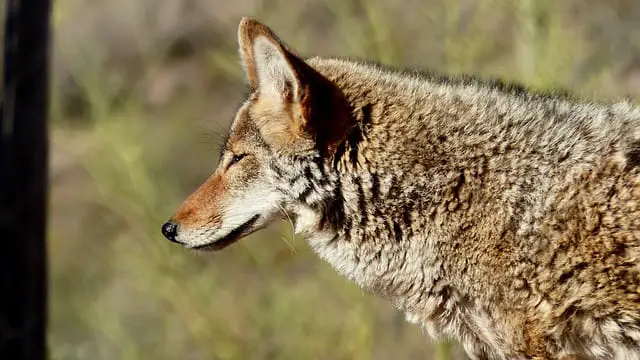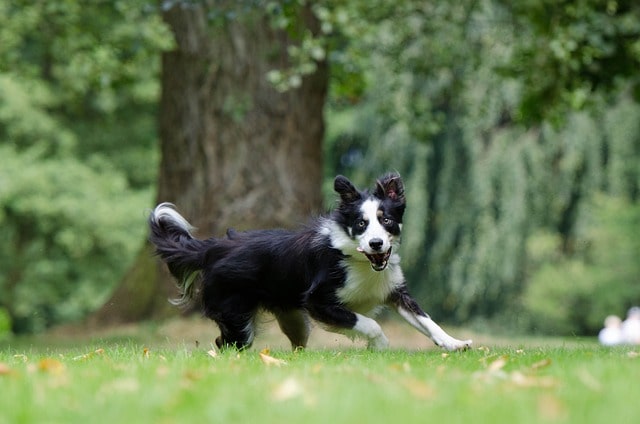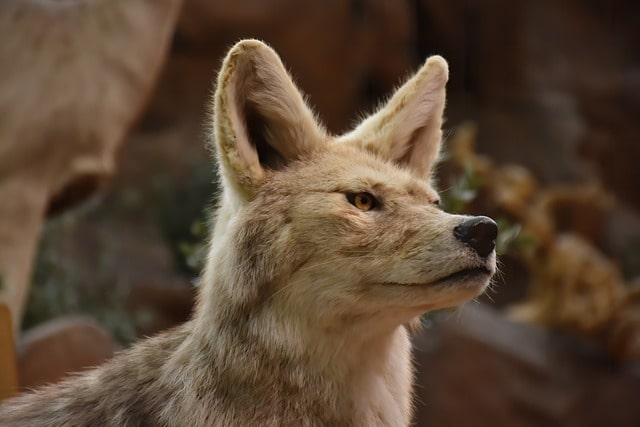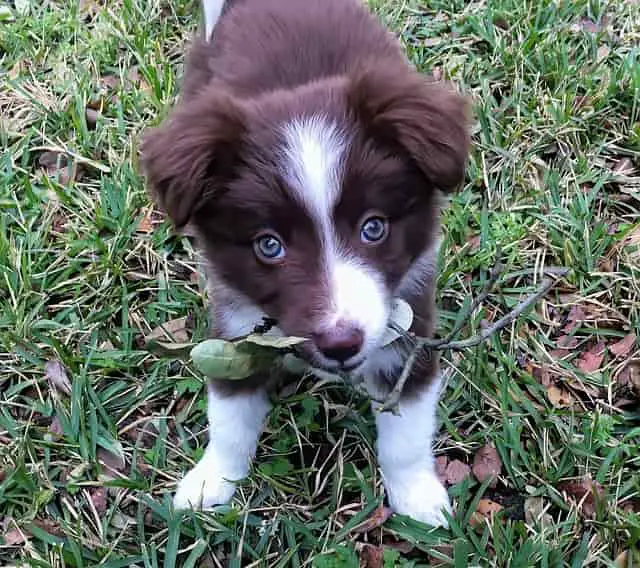Border Collie and Coyote are two distinct species with unique characteristics and behaviors. The Border Collie is a breed of herding dog that is highly intelligent, active, and obedient. On the other hand, the Coyote is a wild canine native to North America, known for its cunning, agility, and adaptability.
Characteristics of Border Collie vs Coyote

Border Collies and Coyotes are known for their unique characteristics and behaviors, just check the table below:
| Characteristic | Coyote | Border Collie |
| Weight | 15 to 50 pounds | From 30 to 45 pounds |
| Appearance | Lean body with golden eyes. Bushy tail and big ears | Slightly elongated body with alert ears. Feathered tail |
| Lifespan | About 10 to 15 years | About 10 to 14 years |
| Coat Colors | Mainly brown, red, and tan | Solid color, bicolor, tricolor, sable and merle |
History of Border Collie vs Coyote

Border Collie and Coyote have a long history of interaction with humans, with the former being valued as a working and competition dog, while the latter is seen as a threat to livestock and human safety.
The coyote was labeled as a human adversary in the mid-19th century. Its name, “Coyote,” is rooted in Aztec history and was brought to the American Southwest by Spanish settlers. The introduction of Anglo Americans in the Southwest in the 19th century resulted in the encounter of the animal, which was referred to as Coyote.
The origin of Border Collies is uncertain, with some theories suggesting they existed during the Roman invasion of Britain in 43 AD and others believing they were introduced by the Vikings during their invasion of England in the 8th and 9th centuries.
Have you come across a canine named Old Hemp? Born in 1893, Old Hemp was a stud owned by Adam Telfer, a famous sheepdog breeder and trainer known for his extensive participation in dog trials. Telfer utilized Old Hemp to breed over 200 puppies, and many believe that he was the ancestor of the Border Collie breed.
Appearance of Border Collie vs Coyote
The Coyote and the Border Collie are easily distinguishable animals with distinct physical features. While they share similarities, such as a long muzzle, pointed ears, and sharp teeth, the Coyote has a larger grayish-brown coat, while the Border Collie has a shorter, denser black and white coat.
Size of Border Collie and Coyote
The average length of a Coyote, excluding its tail which measures 12 to 16 inches, is 30 to 34 inches. They stand at 23 to 26 inches at the shoulder and weigh 15 to 46 lbs. Generally, Northern Coyotes are bigger than southern ones. The largest on record weighing a whopping 74.75 lbs. and measuring 5ft 7in. in total length.
With regards to Border Collie, males typically weigh 30 to 45 pounds, while females weigh 27 to 42 pounds. Males are also generally taller, measuring 19 to 22 inches, while females are shorter, measuring 18 to 21 inches. However, the breed’s size can vary greatly within due to factors such as genetics, diet, and environment.
Coats & Colors

Coyotes have a long, thin coat that ranges from gray to reddish-brown or black, with a white belly and sometimes reddish legs, ears, and face. The coat is further camouflaged by black or dark guard hairs. The Coyote adapts to seasonal changes by adjusting its fur, growing a thicker and heavier coat in the colder months of fall and winter to stay warm.
Coyotes shed their winter coat in the spring, marking the start of warmer months. To aid the shedding process, they will scratch themselves or rub against objects like trees to remove the loose fur. This occurs only once per year.
Border Collies come with either a rough or smooth coat. They have tons of different coat colors like:
- Merle with patterns of red, blue, white and blue, white and red, sable
- White with combinations anywhere from gold, blue and red
- Brindle
- Gold
- Saddleback Sable
Both rough and smooth-coated Border Collies can come from the same litter. Even smooth-coated dogs should have a double coat, with a rough texture like a Labrador Retriever and possibly furnishings on their legs.
The rough-coated dog breed exhibits a wide range of coat thickness and length, with some having thick fur and others appearing smoother. However, an excessive coat or shedding should not be considered a fault in a dog show.
Personality & Temperament of Border Collie vs Coyote
Coyotes and Border Collies exhibit distinct personality traits. Coyotes are wild and timid, while Border Collies are smart, energetic and easily trainable. Coyotes are wary of humans, whereas Border Collies are friendly and loving to their owners.
Family of Border Collie & Coyote
Coyotes are known for having strong wild instincts making them unable to form the same bond as dog. Owners must know that their Coyote’s thought process is distinct from that of a pet. Thus, it cannot perform tasks like a dog.
Border Collies are ideal family pets, with playful personalities and strong watchdog abilities. To ensure their happiness and satisfaction are met, they need a specific living environment. With proper introductions, they are compatible with kids and other animals.
There are several other reasons to get a Border Collie like:
- They are highly interactive and dedicated to their family
- They serve as superb playmates
- They are very diligent in their herding responsibilities
- They make excellent watchdogs
- They need very little grooming
- They enjoy running, playing, and being trained
- They are always ready for an adventure
- They display exceptional loyalty and devotion to their family
- They tend to have good relationships with other pets
Kids
Coyotes attacking children are rare. Nevertheless, do not leave them unsupervised in coyote-prone areas, including your own yard.
Border Collies are great with kids. But parents have to practice caution. Because Border Collies have a tendency to herd, especially to those that did not receive proper training. They may also bark and nip at children, affecting the relationship with these obedient pets.
Other People

Coyote encounters in the news can be confusing for some. Inappropriate responses to these events can worsen the situation. Conflicts can vary from harmless Coyote sightings to pet fatalities and even attacks on humans.
Border Collies are calm and intelligent, but they can become aggressive if provoked. To avoid aggression, it’s best to prevent situations that scare or threaten them, and be careful when introducing them to new people or animals.
Dogs & Other Animals
There are studies exploring relationships between coyotes and other medium-sized predators like skunks, foxes and raccoons with varying outcomes. For example, Coyotes often kill red foxes in rural areas, limiting their populations. However, numerous research is still being done to further this theory.
Border Collies are affectionate, loyal, and naturally friendly to dogs and other animals. Bred to work with animals, they have a strong herding instinct that can be seen to other animals. Border Collies may not all have the instinct to chase moving animals, but it’s part of their DNA and must be taken into account.
Behaviour Issues
Coyotes can pose a threat to people and pets, particularly children, but most attacks can be prevented by modifying human behavior which can help minimize danger.
If you come across a coyote, make a loud noise or throw an object at it. But as a general rule, never run. It will think that you are a prey. During pupping season (May), if a Coyote shows aggression towards a specific area, change your route to avoid confrontation with the normally peaceful animal. Keep in mind that Coyote behavior may vary seasonally and act accordingly.
When a Coyote is aggressive, it may display behaviors such as raised fur, barking, growling, lunging forward and snarling.
As with Border Collies, early socialization is key for them to become well-adjusted adult dogs. This helps mitigate their fear of strangers and excessive protection towards family members. It’s best started while they’re still puppies.
Border Collies need proper training and mental stimulation to avoid behavioral problems like herding, nipping, excessive barking, chewing, and digging. Be ready to provide them with appropriate activities to keep them occupied.
Training & Exercise of Border Collie vs Coyote

Like dogs, Coyotes are trainable and can learn tricks, obedience commands, and useful behaviors such as tracking and hunting. Domesticating a Coyote is distinct from taming a dog. Coyotes are wild and naturally cautious of humans. Early socialization is vital to accustom them to human presence and prevent potential biting or attacking due to fear.
As with a Border Collie, physical and mental health requires exercise and stimulation. Keeping them mentally engaged will promote calmness in all situations. Border Collies require daily exercise to maintain health and prevent restlessness. Aim for 2-3 walks a day, totaling 1-2 hours of physical activity.
Taking Care & Maintenance of Border Collie vs Coyote
Coyotes require a secure outdoor space for their high energy, and should not be kept as indoor pets. If their energy is not properly managed, they can divert it to destructive behavior. For added safety, use a full top and bottom fence with a catch door or double door for secure entry and exit. This will prevent climbing, jumping and digging escapes.
Collies are energetic dogs too that thrive in active homes and with experienced owners. They are easy to train and eager to please their human. However, they may not be suitable for first-time owners. Collies are social dogs and crave companionship. Boredom can lead to destructive behavior, such as chewing, if they’re left alone or don’t receive enough exercise.
Grooming

When trying to groom a Coyote, begin by following the hair’s natural direction. Then, back comb for volume and to prevent matting after a couple of days either by hand combing or forced air. Over-combing can cause roots to tighten as skin dries, making the hair difficult to style later.
Use tools such as compressed air and slicker brush or wide-tooth comb. Brush forward to maintain volume, avoiding combing down which reduces fluff and size perception.
Border Collies have thick coats and are active, so groom them 3 times per week to prevent matting. Introduce grooming as a puppy to reduce grooming issues later, especially with active Border Collies.
Shedding
Coyotes shed their fur once a year from May to July, while Border Collies shed more frequently during summer and winter, in a process called “blowing” their coat or molting.
Border Collies experience coat shedding for approximately 14 days in spring and fall, which may be longer for some dogs. Their coat may appear dull and stringy during this time, but it’s normal and will improve as they grow new fur.
Health of Coyote vs Border Collie
Border Collies are known for their high energy levels, but at mealtime, they can eat too much, causing health problems like bloat and obesity. This is a significant concern for small animals like Border Collies with a low body type.
Coyotes are susceptible to illnesses, including but not limited to:
- Distemper
- Hepatitis
- Parvovirus
- Heartworm
- Different types of mange
They can also carry rabies and tularemia, which can be transmitted to other animals and humans. Coyotes are prone to numerous parasites, like fleas, ticks, worms, flukes, and mites.
Life Span of Coyote vs Border Collie
The typical lifespan of a Border Collie is 12 years, with a range of 10 to 14 years in most cases. They also have a potential to reach 17 years in some instances. Cancer is the leading cause of death, accounting for 23 percent, while old age is the second leading cause at 17 percent.
The lifespan of Coyotes in captivity is 13 to 15 years, but in the wild, they usually don’t survive beyond three years. The oldest recorded wild coyote was an 11-year-old alpha female. In a study of Coyotes in the Chicago area, it was found that they have a 60% chance of living through their first year.
Diet & Nutrition
For Border Collies as family pets, a high-quality premium pet food designed for medium or all breeds is suitable with 1 to 2 hours of exercise per day. For working Border Collies with high levels of daily exercise, a higher calorie “high performance” diet may be necessary. It’s important to monitor their weight, as these diets can cause weight gain if the energy isn’t burned off.
If you choose to keep a Coyote as a pet, it is important to provide a balanced diet that includes the following:
- Raw meat (85-90%)
- Raw bones (10%)
- Liver (5%)
- Combination of offal like pancreas, spleen, kidney (5%)
The remaining portion of their diet can be made up of vegetables, fruits, and eggs. Coyotes need a mainly meat-based diet and cannot get everything they need from kibble alone, so it is important to ensure they receive a raw meat-heavy diet.
Health Issues
The leading causes of death in Border Collies are old age, cancer, and brain-related issues. Additionally, they are more prone to certain health problems, including:
- Hearing Loss
- Hip Dysplasia
- Collie Eye Anomaly
- Elbow Dysplasia
- Epilepsy
Humans are the leading cause of death for Coyotes, due to hunting for their fur, controlling populations near domestic or game animals, and accidents involving vehicles.
In their natural habitat, Coyotes are more likely to die from infectious diseases like mange, canine distemper, and rabies. Mange can be easily identified as it causes hair loss on certain parts of their body, starting from the tail and flanks, and may lead to death from exposure in cold weather.
Cost of Coyote and Border Collie
The cost of buying a Coyote or Border Collie as a pet can vary widely. Coyote ownership may be restricted by state laws and require special permits. Border Collies can cost anywhere from a few hundred to a few thousand dollars, depending on the breeder and location. Both pets require ongoing expenses for food, vet care, and supplies.
Puppies

The cost of a Border Collie puppy ranges from $700 to $3,500, depending on factors such as breeder location, gender, age, and pedigree. Higher prices can be expected for a top-quality puppy with a champion bloodline.
Avoid purchasing Coyote puppies that are offered at a low price, as this could indicate a potential issue with the animal. Typically, Coyote puppies cost around $400 to $800 from a reputable source. If you come across a puppy for sale at a significantly reduced cost, it is advisable to exercise caution and consider other options.
Breeders & Centers
Adopting a Border Collie or Coyote can be a cost-effective option for those looking to bring a furry friend into their home. Adoption is also a responsible choice, as it helps reduce overpopulation in shelters and gives a deserving animal a forever home. Before deciding to adopt, it is important to research both breeds and make sure they are a good fit for your lifestyle and family.
Conclusion: Which Is Better, Coyote or Border Collie?
The decision between a Border Collie and a Coyote ultimately comes down to personal preference, lifestyle, and responsible pet ownership.
Border Collies are highly intelligent, energetic dogs that make great family pets, but require a lot of mental and physical stimulation to stay happy and healthy. On the other hand, owning a Coyote as a pet is illegal in many states and requires a unique set of skills to ensure proper care and socialization.
Before deciding, it is important to carefully consider the responsibilities and challenges of owning each breed, as well as local laws and regulations. Ultimately, the best pet is one that fits well with your lifestyle and family, and one that you can provide with a safe, loving home for their entire life.


